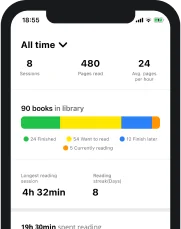As readers, we are often required to look further into our reading habits and determine what we can improve. Our time is generally limited, and we tend to depend on a wide variety of factors that influence our performance when reading. To regain some control over our habits, levels of comprehension, and levels of information retention, most of us start looking for the best reading strategies. What most of us fail to understand or simply overlook is that pre-reading strategies are actually equally important.
Here at Basmo, we want to help you learn everything you need to know in order to fully maximize your potential as a reader. Since pre-reading strategies are responsible to a certain extent for our success when reading with a purpose, we did some research to put together a list of things you should know about pre-reading and how it can help you achieve more.
Understanding the pre-reading meaning can be a complex process.
What is pre reading?
By its definition, pre-reading is a general term that refers to all the actions a reader must complete before reading, as part of a strategy to engage with the text on a deeper level during the actual reading session. Pre-reading gives you the chance to take a look at the big picture before going into more detail.
There are several steps and techniques that define the pre-reading strategy:
- Skimming: the process of reading a text quickly in order to get a sense of its overall structure and key concepts
- Scanning: the process of focusing on particular information or keywords within the book or reading material, such as headings, subheadings, and bolded or italicized text
- Previewing: the process of getting a sense of the main ideas and purpose of the text by looking at the introduction, headings, chapter names, and summary.
Why is pre-reading important?
There are several reasons why pre-reading is an essential part of a successful active reading session. Pre-reading strategies set the tone for your active reading session, they create a skeleton for your learning curve and provide you with the necessary framework for the information you are about to absorb.
Pre-reading helps you gain a general understanding of the text. By using pre-reading strategies, you get a sense of the ideas and concepts you are going to read about in your upcoming session, as well as the structure of the material and how the data is organized.
Through pre-reading, you will get to identify some key terms and concepts before you actually start reading. This is sometimes helpful during the later stages of your active reading session, as having a basic understanding of some unfamiliar terms and concepts before you even get started will save you some precious time.
Pre-reading gives your upcoming reading session a clear purpose. It can help you better understand why you are reading a particular text, what you can achieve by reading it, and what concepts or ideas you are working to grasp. This, in turn, will give you the motivation boost you need to stay focused and constantly look for the exact information you want to acquire.
Including pre-reading strategies in your reading habits can actually save you some time, even though at first it may seem like you’re just adding an extra step to your activities. Through pre-reading you can actually determine whether a certain book or reading material is actually what you are looking for, whether it contains the information you are looking for and therefore worth reading or not. This is obviously important, as it can save you the trouble of reading something that doesn’t meet your expectations, only to realize that you need to put in just as much effort one more time to read another book on the same subject.
What are the most popular pre-reading strategies?
There are several distinct types of pre-reading. These strategies might differ in terms of complexity and technique, but the one thing they do have in common is the fact that they contribute to outlining the framework of your upcoming study or active reading session. These are the most important pre-reading strategies you should explore.
1. Expectation outline
As the name suggests, this pre-reading strategy represents a technique through which you get to set certain expectations for the upcoming reading session. For example, you could use this strategy to create a set of questions you expect the reading material to answer to.
2. Knowledge rating
This technique involves evaluating your own knowledge of certain topics or concepts before starting to read more about them. That way, you involuntarily access your memory, and not only do you bring out the information you already possess on that particular topic, but you also evaluate it to a certain extent.
3. KWL chart
Using a KWL chart can help your pre-reading process tremendously. You can easily get your hands on a pre-created KWL chart or create your own. The way this works is pretty simple. You should create a table with three columns, as follows:
- K column: write down everything you already know about the topic you are about to explore
- W column: write down what you want to learn from the upcoming reading session
- L column: leave this blank until your reading session is over. Once you’re done reading, return to this section and write down the things you learned.
4. KWHL chart
Similar to the KWL chart, KWHL follows the same pattern, with one added step: the H column on the chart is reserved for writing down how you expect to learn the things you want to learn.
5. SQ3R
While SQ3R is in fact a rather complex reading strategy, and not just a pre-reading technique, it does involve some stages where the pre-reading should be done. There are five main steps in the SQ3R:
- Survey – pre-reading stage
- Question – pre-reading stage
- Read
- Recite
- Review
SQ3R is a particularly effective reading and learning strategy, and it relies, among other things, on the pre-reading strategy.
How to do pre-reading?
Pre-reading might enhance reading comprehension and streamline the reading procedure. Here are some top tips for making the most of pre-reading:
- Decide why you are reading the text. Having a clear purpose for your reading can assist you in staying focused on the most crucial details and avoiding distractions.
- Skim the text to get a quick overview of the reading material’s organization and key concepts. Check out the headings, subheadings, and any other visuals, such charts or pictures.
- Read the first and last paragraphs, as well as any introduction or ending parts, to get an overview of the content. These can offer context and help in your understanding of the text’s main ideas.
- Take a look at the text’s vocabulary. If you come across any new words, try to deduce their meaning from context or look them up in a dictionary.
- Make predictions regarding the things you stand to gain in terms of knowledge from reading the content in its entirety. Use the information you gathered during pre-reading to try and estimate how valuable the reading material is to you and how well it fits your needs.
Another way of pre-reading is by using the BASMO method (Browsing, Annotating, Summarizing, Mapping, and Outlining).
- Browsing: skimming the book or reading material to get a grasp of its structure and key elements.
- Annotating: making notes in the margins of pages or underlining key portions with a highlighter will help you remember critical details as you read.
- Summarizing: after pre-reading the text, make a quick summary of its key points.
- Mapping: map the text to highlight the connections between various ideas and concepts.
- Outlining: arrange the information you gathered from the text in the previous steps into an outline with main ideas and supplementary information.
While the pre-reading examples I presented above are generally pretty self-explanatory, one addition that is worth making is that on top of being a great acronym for browsing, annotating, summarizing, mapping, and outlining, Basmo is also the name of our reading tracking app. And as you would imagine, it can be pretty useful in pre-reading strategies. Here’s why.
How can Basmo help with pre-reading?
Basmo makes note-taking an easy and facile adventure. As I mentioned above, the success of pre-reading strategies sometimes depends on note taking. Jotting down the relevant information, making your outline, KWL or KWHL charts requires you to put pen to paper. With Basmo, you can do all that with minimal effort.
As soon as a reading session is launched, the note-taking feature becomes available and you can immediately start typing. The notes can be easily formatted however you see fit in terms of fonts, font sizes, and colors, which means you will always find the relevant information quickly if your notes are well-organized right from the start.
You can use Basmo to keep a reading journal. Sometimes taking notes while reading or pre-reading isn’t enough. If you want to expand on your ideas from the pre-reading sessions, you can always use the journaling feature from Basmo. This gives you even more freedom in terms of space and structure and comes with the added benefit of always being available, regardless of the book you are currently reading.
Basmo tracks your reading performance. A pre-reading session is obviously a method through which you are trying to achieve a better level of comprehension and information retention by using as little time as possible. That last part is of utmost importance.
With Basmo, since every reading session is automatically tracked, timed, analyzed in terms of performance, you can always pay attention to how much time you spend pre-reading. Moreover, you can also keep in mind how quickly you go over the material in pre-reading sessions. Basmo tracks your reading speed across every single reading session, which makes it quite easy for you to analyze your stats and adjust things as you go.
Final thoughts
Pre-reading strategies are a great way for readers to maximize their potential in a limited timeframe. By looking over the material at hand before actually analyzing and reading it, you can easily decide whether the information you are looking for is available in the content and you can familiarize yourself with the concepts you are about to study. Use Basmo to make pre-reading a better, more interesting, and more efficient strategy.
Image by storyset on Freepik







